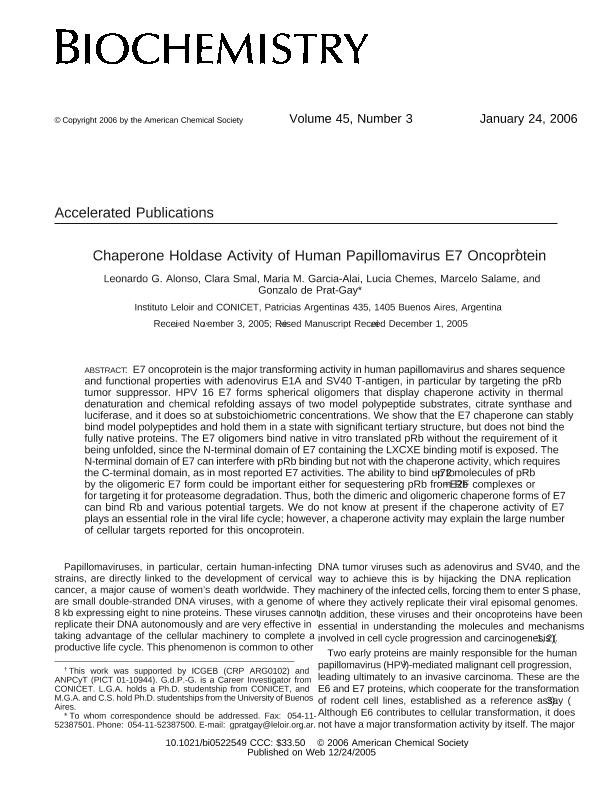Artículo
Chaperone holdase activity of human papillomavirus E7 oncoprotein
Alonso, Leonardo Gabriel ; Smal, Clara
; Smal, Clara ; Garcia Alai, Maria M.; Chemes, Lucia Beatriz
; Garcia Alai, Maria M.; Chemes, Lucia Beatriz ; Salame, Marcelo; de Prat Gay, Gonzalo
; Salame, Marcelo; de Prat Gay, Gonzalo
 ; Smal, Clara
; Smal, Clara ; Garcia Alai, Maria M.; Chemes, Lucia Beatriz
; Garcia Alai, Maria M.; Chemes, Lucia Beatriz ; Salame, Marcelo; de Prat Gay, Gonzalo
; Salame, Marcelo; de Prat Gay, Gonzalo
Fecha de publicación:
01/2006
Editorial:
American Chemical Society
Revista:
Biochemistry
ISSN:
0006-2960
e-ISSN:
1520-4995
Idioma:
Inglés
Tipo de recurso:
Artículo publicado
Clasificación temática:
Resumen
E7 oncoprotein is the major transforming activity in human papillomavirus and shares sequence and functional properties with adenovirus E1A and SV40 T-antigen, in particular by targeting the pRb tumor suppressor. HPV 16 E7 forms spherical oligomers that display chaperone activity in thermal denaturation and chemical refolding assays of two model polypeptide substrates, citrate synthase and luciferase, and it does so at substoichiometric concentrations. We show that the E7 chaperone can stably bind model polypeptides and hold them in a state with significant tertiary structure, but does not bind the fully native proteins. The E7 oligomers bind native in vitro translated pRb without the requirement of it being unfolded, since the N-terminal domain of E7 containing the LXCXE binding motif is exposed. The N-terminal domain of E7 can interfere with pRb binding but not with the chaperone activity, which requires the C-terminal domain, as in most reported E7 activities. The ability to bind up to ∼72 molecules of pRb by the oligomeric E7 form could be important either for sequestering pRb from Rb-E2F complexes or for targeting it for proteasome degradation. Thus, both the dimeric and oligomeric chaperone forms of E7 can bind Rb and various potential targets. We do not know at present if the chaperone activity of E7 plays an essential role in the viral life cycle; however, a chaperone activity may explain the large number of cellular targets reported for this oncoprotein.
Archivos asociados
Licencia
Identificadores
Colecciones
Articulos(IIBBA)
Articulos de INST.DE INVEST.BIOQUIMICAS DE BS.AS(I)
Articulos de INST.DE INVEST.BIOQUIMICAS DE BS.AS(I)
Citación
Alonso, Leonardo Gabriel; Smal, Clara; Garcia Alai, Maria M.; Chemes, Lucia Beatriz; Salame, Marcelo; et al.; Chaperone holdase activity of human papillomavirus E7 oncoprotein; American Chemical Society; Biochemistry; 45; 3; 1-2006; 657-667
Compartir
Altmétricas



